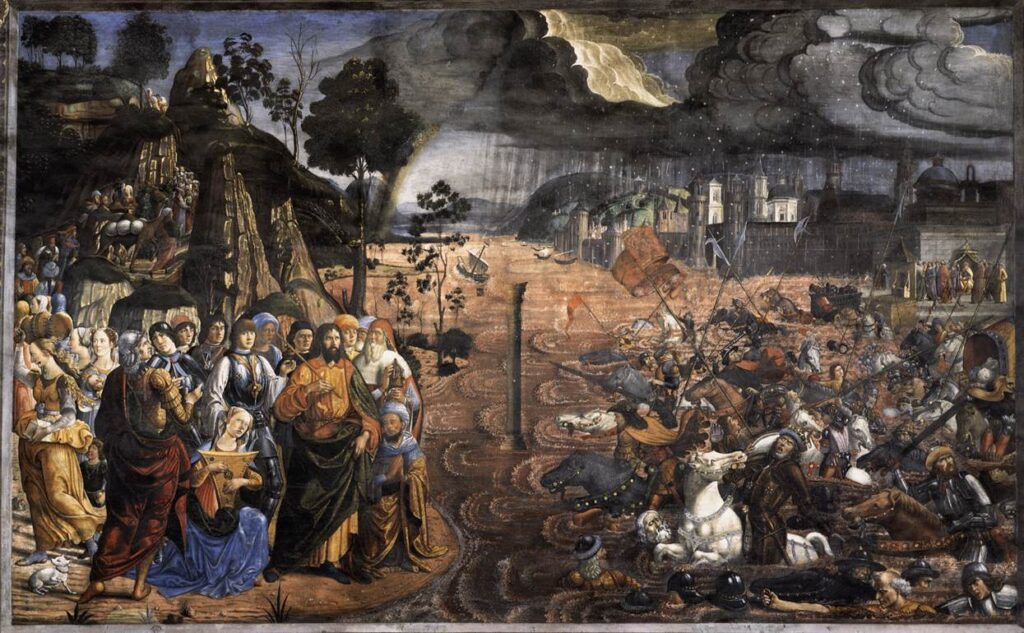
The Apostles Peter and Andrew kneel on the ground before Christ. They wear cloaks as if ready to set out on a journey. They are shown barefoot, in accordance with what Christ will say to them later on in the gospel when he sends them out: “Take no gold, nor silver, nor copper in your belts no bag for your journey, nor two tunics, nor sandals nor staff” (Mt 10:10). Behind them a large body of water stretches back to a the hazy distance. Darker land rises steeply on either side, so that the eye is drawn beyond them to the light filled horizon. Behind on the left, we see them again, but this time in their boat with their nets and Christ is on the bank saying to them, “Follow me and I will make you become fishers of men” (Mk 1:17) On the opposite side, we see them for a third time. Now they accompany Christ as he calls James and John. The brothers are shown with their father Zebedee in a boat mending their nets. Looking at this fresco in isolation, and noting the dominance of the body of water, the link between following Christ and baptism is obvious. However, this fresco is not meant to be seen on its own. It one of a sequence of scenes from the life of Christ painted on the north wall of the Sistine Chapel. These correspond to scenes from the life of Moses on the south wall. The image on the south wall directly opposite this one shows Moses and the people of Israel, who have just crossed the Red Sea dry shod, and are watching as Pharaoh and his soldiers drown.

The Red Sea is at the centre of that image just as the Sea of Galilee is at the centre of this image. The crossing of the Red Sea can be seen then as a foreshadowing the waters of baptism. The dark horizon, the storm and churning water and drowning Egyptians are in strong contrast with the calm waters of the Sea of Galilee opposite. In fact another layer of symbolism derives from the chapel’s founder. This was Francesco della Rovere (1414 -1484) who became Sixtus IV in 1471. The name means “oak” and the frescos, including this one, show a rather large number of oak trees. Sixtus IV was a Franciscan Friar, who was a noted scholar, who became the Minister General of the Order in 1464, was then made a Cardinal, and, finally, was elected Pope. The scenes from the life of Christ have a particular focus on St Peter as you might expect from the chapel of his successor. But the focus on Moses as the precursor of Christ was less usual. The intention was to draw a parallel between Moses and Christ as givers of the old written Law and the new Law of the Gospel, respectively. However, another layer of symbolism only becomes apparent when you consider that the Pope who built the chapel was a Franciscan. In all probability, it was Sixtus IV himself who specified the content of the fresco cycles on either wall. His devotion St Francis and the to the Franciscan Order continued. It is said that he continued to wear his habit as Pope and was buried in it. In particular, he was behind the canonisation of the Franciscan theologian St Bonaventure in 1482. These frescoes need to be seen through the eyes eyes of Pope Sixtus. For someone like Pope Sixtus, St Francis and the Order represented a return to the golden age of the early Church and St Francis was Christ like in a very strong sense, something which his stigmata confirmed. In his writings, St Bonaventure had compared St Francis not just to Christ and to Moses. He adapted the language of the exodus to compare the Order founded to the promised land, and the corrupt and profane world the friars had left behind them to the slavery of Egypt. He wrote, “The cross of Christ will part the waters of the sea for them like Moses’ rod and they shall traverse the desert to the promised land of the living, where they shall enter by the miraculous power of the Cross, having crossed the Jordan of our human mortality”. This promised land, which is the life of the world to come, is just visible, bathed in light which shines through the distance haze at the very centre of Ghirlandaio’s fresco.
The Catholic Chaplaincy serves the students and staff of the University of Edinburgh, Edinburgh Napier University and Queen Margaret University.
The Catholic Chaplaincy is also a parish of the Archdiocese of St Andrews and Edinburgh (the Parish of St Albert the Great) and all Catholic students and staff are automatically members of this parish.